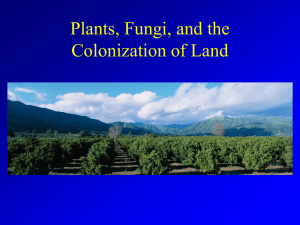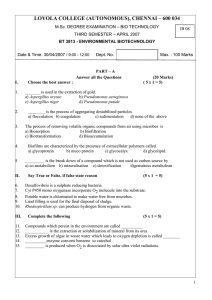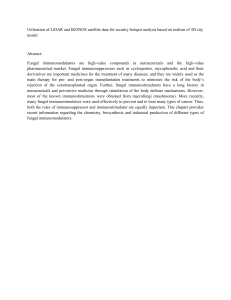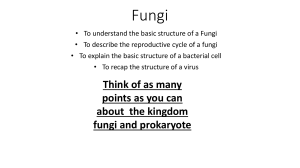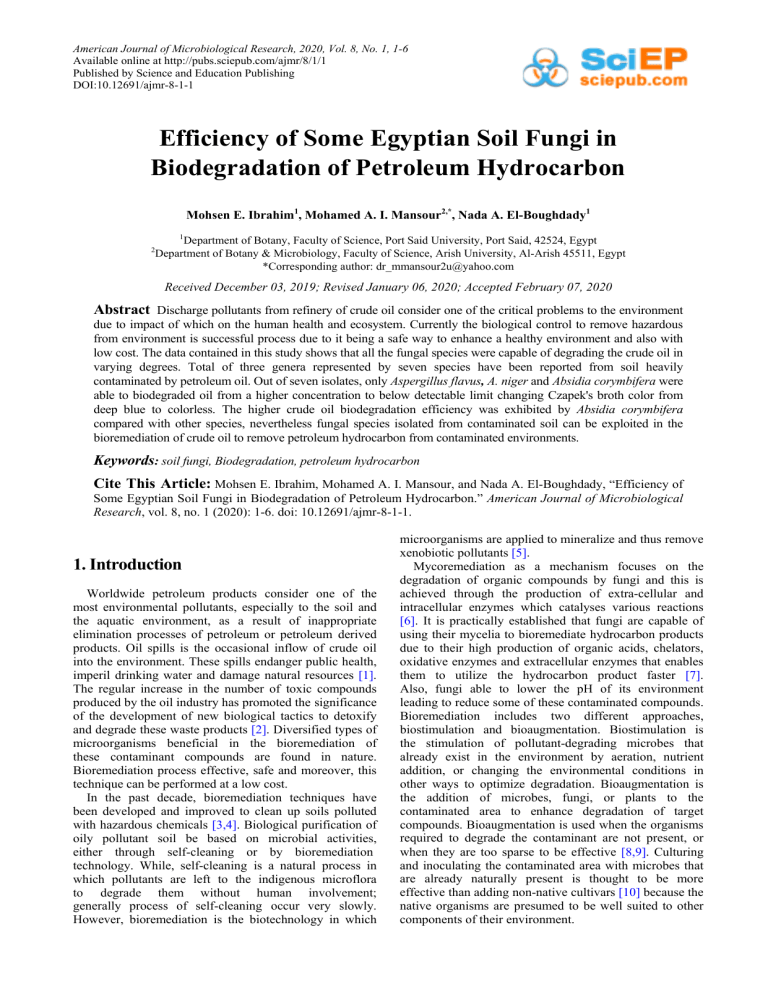
American Journal of Microbiological Research, 2020, Vol. 8, No. 1, 1-6 Available online at http://pubs.sciepub.com/ajmr/8/1/1 Published by Science and Education Publishing DOI:10.12691/ajmr-8-1-1 Efficiency of Some Egyptian Soil Fungi in Biodegradation of Petroleum Hydrocarbon Mohsen E. Ibrahim1, Mohamed A. I. Mansour2,*, Nada A. El-Boughdady1 1 Department of Botany, Faculty of Science, Port Said University, Port Said, 42524, Egypt Department of Botany & Microbiology, Faculty of Science, Arish University, Al-Arish 45511, Egypt *Corresponding author: dr_mmansour2u@yahoo.com 2 Received December 03, 2019; Revised January 06, 2020; Accepted February 07, 2020 Abstract Discharge pollutants from refinery of crude oil consider one of the critical problems to the environment due to impact of which on the human health and ecosystem. Currently the biological control to remove hazardous from environment is successful process due to it being a safe way to enhance a healthy environment and also with low cost. The data contained in this study shows that all the fungal species were capable of degrading the crude oil in varying degrees. Total of three genera represented by seven species have been reported from soil heavily contaminated by petroleum oil. Out of seven isolates, only Aspergillus flavus, A. niger and Absidia corymbifera were able to biodegraded oil from a higher concentration to below detectable limit changing Czapek's broth color from deep blue to colorless. The higher crude oil biodegradation efficiency was exhibited by Absidia corymbifera compared with other species, nevertheless fungal species isolated from contaminated soil can be exploited in the bioremediation of crude oil to remove petroleum hydrocarbon from contaminated environments. Keywords: soil fungi, Biodegradation, petroleum hydrocarbon Cite This Article: Mohsen E. Ibrahim, Mohamed A. I. Mansour, and Nada A. El-Boughdady, “Efficiency of Some Egyptian Soil Fungi in Biodegradation of Petroleum Hydrocarbon.” American Journal of Microbiological Research, vol. 8, no. 1 (2020): 1-6. doi: 10.12691/ajmr-8-1-1. 1. Introduction Worldwide petroleum products consider one of the most environmental pollutants, especially to the soil and the aquatic environment, as a result of inappropriate elimination processes of petroleum or petroleum derived products. Oil spills is the occasional inflow of crude oil into the environment. These spills endanger public health, imperil drinking water and damage natural resources [1]. The regular increase in the number of toxic compounds produced by the oil industry has promoted the significance of the development of new biological tactics to detoxify and degrade these waste products [2]. Diversified types of microorganisms beneficial in the bioremediation of these contaminant compounds are found in nature. Bioremediation process effective, safe and moreover, this technique can be performed at a low cost. In the past decade, bioremediation techniques have been developed and improved to clean up soils polluted with hazardous chemicals [3,4]. Biological purification of oily pollutant soil be based on microbial activities, either through self-cleaning or by bioremediation technology. While, self-cleaning is a natural process in which pollutants are left to the indigenous microflora to degrade them without human involvement; generally process of self-cleaning occur very slowly. However, bioremediation is the biotechnology in which microorganisms are applied to mineralize and thus remove xenobiotic pollutants [5]. Mycoremediation as a mechanism focuses on the degradation of organic compounds by fungi and this is achieved through the production of extra-cellular and intracellular enzymes which catalyses various reactions [6]. It is practically established that fungi are capable of using their mycelia to bioremediate hydrocarbon products due to their high production of organic acids, chelators, oxidative enzymes and extracellular enzymes that enables them to utilize the hydrocarbon product faster [7]. Also, fungi able to lower the pH of its environment leading to reduce some of these contaminated compounds. Bioremediation includes two different approaches, biostimulation and bioaugmentation. Biostimulation is the stimulation of pollutant-degrading microbes that already exist in the environment by aeration, nutrient addition, or changing the environmental conditions in other ways to optimize degradation. Bioaugmentation is the addition of microbes, fungi, or plants to the contaminated area to enhance degradation of target compounds. Bioaugmentation is used when the organisms required to degrade the contaminant are not present, or when they are too sparse to be effective [8,9]. Culturing and inoculating the contaminated area with microbes that are already naturally present is thought to be more effective than adding non-native cultivars [10] because the native organisms are presumed to be well suited to other components of their environment. 2 American Journal of Microbiological Research Generally, crude oil composed of four major constituents [11] saturated hydrocarbons, aromatic hydrocarbons, asphaltenes and resins. The toxicity of crude oil or petroleum products varies widely, depending on their composition, concentration, environmental factors and on the biological state of the organisms at the time of the contamination [12]. Many microorganisms are capable of using hydrocarbons as the sole carbon and energy source. Oil (or hydrocarbon) utilization potential is widely distributed among prokaryotic and eukaryotic microorganisms. In case of the high molecular weight hydrocarbons only bacteria and fungi show a capacity to use these compounds as the only carbon and energy source [13]. Newly, many investigators studied the role of fungi in biodegradation process of petroleum products and the most common fungi which have been recorded as a biodegrades belongs to: firstly yeasts which include Candida, Dabaromyces, Endomyces, Leucosporidium, Lodderomyces, Metschnikowia, Pichia, Rhodotorula, Rhodosporidium, Saccharomycopsis, Schwanniomyces, Selenotila, Sporidiobalus, Sporoboloyces, Torulopsis, Trichosporon and Wingea. Secondly fungal biota such as Absidia, Aspergillus, Aureobasidium, Beauveria, Botrytis, Cephalosporium, Cladosporium, Corellospora, Cunnninghamella, Dendyphiella, Fusarium, Geotrichum, Gliocladium, Hormodendrum, Lulworthia, Mortierella, Mucor, Paecilomyces, Penicillium, Phiolophora, Phoma, Pleurotus, Polyporus, Rhizopus, Scedosporium, Scoleobasidium, Sporotrichum, Talaromyces, Varicosporina and Verticillium [4,14,15,16]. The main intention of the present study was to isolate, characterize and identify fungal biota from crude oil polluted soil and determine their ability to biodegrade this oil under laboratory conditions (in vitro). 2. Materials and Methods 2.1. Source of Crude Oil Crude oil, which is used to test capability of fungi isolates on biodegradation was obtained from the Burg El Arab (BEA) oil field in western desert that produce crude oil and equipped to refinery for the refining. It was transferred to laboratory in dark glass bottle closed tightly and kept in a cold and dark place until to use. 2.2. Soil Sampling The soil samples that were used in this study were obtained in October 2017 from grounds of three automobile garages in Port Said city where spillage of motor oil had occurred over a long period. Soil samples were taken randomly just 5 cm below the soil surface by hand trowel. Samples were transported to the laboratory in sterile plastic bags for fungal isolation immediately. Necessary the samples were stored under refrigeration at 4°C until isolation; this was no later than 48 hours after sampling. 2.3. Isolation of Fungi from Oil Contaminated Soils Collected soil samples were homogeneously mixed with removal of stones and other unwanted soil debris using 2 mm sieve followed by 1 g of soil was transferred to Petri dishes and plated on sterile Czapek's yeast extract agar (CYA) medium (Composition in g/L: sucrose 30 g, sodium nitrate 3 g, potassium dihydrogen phosphate 1 g, magnesium sulphate 0.5 g, potassium chloride 0.5 g, ferrous sulphate 0.01 g, yeast extract 5 g, agar 20 g, distilled water 1000 ml). The medium supplemented by chloramphenicol (250 mg/l) and Rose bengal (1/15000) to suppress bacterial growth. Plates were incubated at 30°C for 3 days or more depending on the rate of growth. The grown cultures were carefully sub-cultured onto fresh Czapek's plates and incubated until the fungus begins to sporulation. A part of the pure culture was then transferred into Czapek's plates and incubated at 30°C for six days and stored as stock cultures at 4°C in the [14,17,18]. 2.4. Morphological Characterization Isolated Fungal Taxa Macro-morphology (colony diameter, colony color, reverse and exudates) and micro-morphology (conidia & phialides if present, mycelium) of isolated fungal species were used as criterions for morphological identification of the fungal biota [19]. 2.5. Determination of fungal Growth Ability under Petroleum Hydrocarbon Pollution Degradation studies were carried out using (CYA) medium without agar and chloramphenicol. The Czapek's broth was supplemented with 5 ml of crude oil as the sole carbon source. Two agars plug 1 cm2 of the pure cultures of each the fungal isolates were inoculated into CYA (100 mL/250 mL flask) containing sterile crude oil as a sole carbon source without redox indicator. All flasks were incubated at room temperatures with constant shaking about 100 rpm for 4 days at 30 ± 2°C. The oil in the flasks was monitored daily for dispersion and emulsification of oil in synchronous with fungal growth. The control flasks without fungal candidates were incubated at same condition. 2.6. Biodegradation Assay of Crude Oil 0.1 ml of Tween 80 (0.1%) and 0.05 ml of methylene blue solution (redox indicator) were incorporated into the previous broth flasks. The isolates to be assayed were incubated in a shaker (100 rpm, 30°C) for 7 days. After incubation for 7 days, the broth in flasks which changed from deep blue to colorless likely due to oxidized hydrocarbons products was subjected to filtration by filter papers. Pellets were discarded and the supernatant retained. Supernatant thus obtained were measured by spectrophotometer. 2.7. Screening for Biodegradation Potentials Two agar plugs (1 cm2 each) of a pure growth of each isolate were inoculated into Czapek's extract broth (50 ml/250 Erlenmeyer flask) incorporated with sterile crude oil (1% v/v), redox indicator (2 % v/v) and Tween American Journal of Microbiological Research 80 (0.1% v/v). The control flask had no organism incubation was at room temperature (28-30°C) with constant shaking at 150 rev/min for 5 days [20,21]. The aliquots in the flasks were monitored daily for color change (from deep blue to colorless). 3. Results 3 Table 2. Mean count and frequency of fungal biota isolated from petroleum polluted soil No. 1 2 3 4 5 6 7 Species Aspergillus flavus Aspergillus niger Absidia corymbifera Aspergillus terreus Aspergillus fumigates Emericella nidulans Aspergillus sydowii Count 833 733 500 222 100 133 133 Frequency 100% 100% 100% 66% 66% 66% 66% 3.1. Overview During this part of study, a total of three genera represented by seven species have been reported from soil heavily contaminated by petroleum oil. Isolated fungal biota belong to three taxonomic classes of which Hyphomycetes comes first by being represented by five species followed by Ascomycetes and Zygomycetes by being showing one species each (Table 1). Table 1. Taxonomic classes of isolated fungal taxa Class No. of species isolated % Hyphomycetes 5 71.4 Ascomycetes 1 14.3 Zygomycetes 1 14.3 Total No. of species 7 100% 3.2. Cultural Characteristics of Fungi from Oil Contaminated Soils A total of seven fungal isolates were obtained from oil contaminated soil using Czapek's yeast extract agar defined as Aspergillus niger, Absidia sp, Emericella sp, Aspergillus flavus, Aspergillus fumigatus, Aspergillus terreus and Aspergillus sydowii (Table 2 & Figure 1). These isolates were able to grow within 4-7 days of incubation at 30°C. Figure 1. Agar plates showing isolated fungal species (macromorphology) 3.3. Microscopic Characterization of Fungal Isolates Different characteristics for the isolates were noted when observed under light microscope at a magnification of x 400. Aspergillus flavus had double walled vesicles with conidia spreading from the strigmata, vesicles being flask shaped (Figure 2). Aspergillus niger had conidiophores terminates in vesicles, smooth walled, colorless with brownish shade. Absidia had sporangiophores are hyaline, simple or sometimes branched and sporangia are globose and supported by a characteristic funnel-shaped apophysis (Figure 2). Aspergillus terreus had globose vesicles and had biseriate conidial head. Figure 2. Micro-morphology of some isolated fungal biota 4 American Journal of Microbiological Research Figure 3. Ability of some selected fungal isolates in biodegradation of crude oil: a- control without fungal candidates, b- control without fungal candidates but with crude oil, c & d- rate of biodegrade by tested isolates 3.4. Biodegradation Potentials of Aspergillus flavus, Aspergillus niger and Absidia corymbifera Czapek's broth changed color from blue to colorless meaning that the isolates responsible might be potential hydrocarbon oxidizers. Out of seven isolates, only Aspergillus flavus, A. niger and Absidia corymbifera were able to biodegraded oil from a higher concentration to below detectable limit changing Czapek's broth color from deep blue to colorless. Figure 4. The end of fungal biodegradation 3.5. Spectrophotometer Analysis Spectrophotometer apparatus was used to determine the residual hydrocarbon present in the media after 14 days of incubation. Control was first obtained by injection 3 μl into the cuvette and a reading is taken as a standard. After taking the standard, 3 μl of each sample was injected to get the reading. Each sample measuring 3 μl was injected into the cuvettes in a capillary column inside spectrophotometer and measured at wavelength 609 nm. Table 3. Rate of absorbance (nm) light of tested fungal taxa in liquid media revealing the ability of these fungi in biodegradation of crude oil Species Absorbance (nm) Absidia corymbifera 0.246 Aspergillus niger 0.176 Aspergillus flavus 0.049 4. Discussion Fungal analysis of surveyed oil polluted soil samples based on dilution-plate technique using Czapek’s-yeast extract agar media revealed that three genera represented by seven fungal species were identified (Table 2). The genus Aspergillus showed high occurrence by being represented by 5 species followed by Absidia and Emericella represented by only one species each. Aspergillus flavus; A. niger, and Absidia corymbifera were the most common species. The remaining fungal genera and species were less frequent. Most of the recorded fungal species in this study had identified before oil contaminated soil. Generally, different microorganisms (including bacterial & fungal species) have been reported to be capable of biodegrading effectively petroleum hydrocarbons [13]. Although essential biodegradation is best demonstrated in field situations [15,16], the laboratory studies provide greater control and are useful in providing a basis to distinguish between biotic and abiotic processes, and to determine the optimized conditions for the biodegradation. In our investigation, isolation of fungal biota from oily contaminated soil indicated that, the isolates were able to exist in the contaminated environment while those that could not survive in this environment being eliminated by the unfavorable conditions caused by the oil [14]. Only two genera represented by three species were able to biodegraded crude oil namely; Absidia corymbifera, Aspergillus niger and Aspergillus flavus. The result of the present study shows that Absidia corymbifera had higher biodegradation potential then A. niger and A. flavus. This result was also demonstrated by [21,22,23]. Our result has been also similar to the findings of [24] which showed that Aspergillus versicolor and A. niger exhibited biodegradation of hydrocarbons higher than 98%. The result was obtained by [25] in their study obtained that the fungus Penicillium chrysogenum loss of crude oil concentration percentage in axenic culture to 76% after a month period. [18] study the capabilities of fungi to degrade hydrocarbons, obtained result showed that A. niger, A. fumigatus, Fusarium solani and Penicillium funiculosum degraded of up to 75% of the contaminants after 21 days. American Journal of Microbiological Research However, our data is in agreement with previous studies that have identified numerous fungal species including Acremonium sp., Aspergillus sp., Fusarium sp., Mucor sp., Phanerochaete sp., Phialophora sp. and Trichoderma sp. that can degrade Polycyclic Aromatic Hydrocarbons (PAHs) such as naphthalene [26,27], phenanthrene [27,28], pyrene [28,29] and benzo[a]pyrene [30,31,32]. The outstanding mycelia growth of fungal biota used may be due to the higher production of extra-cellular enzymes and organic acids that enabled them to utilize the hydrocarbon faster. This agree with the findings of [7]. that mycelia mats are used for bioremediation because they produce extra-cellular enzymes and acids that break and dismantle the long chains of hydrocarbon, the base structure common to oils, petroleum products and many other pollutants. [33] studied the ability for removal of hydrocarbons was characteristic for fungal strains and probably associated with their high degree of adaptation for living in habitats heavily contaminated with petroleum hydrocarbons. It was observed that petroleum hydrocarbon removal rates depended on fungal proteolytic activity, biomass production, and easily degradable protein content in the medium. Our data also showed that the use 0.1% of Tween 80 facilitated the transport of the oil to tested fungi and enhanced the metabolism of the hydrocarbon. This result agree with the finding of [24]. The high rate of hydrocarbon degradation by the three fungal candidates could emerge from their massive growth and enzyme production responses during their growth phases. This could be supported by the reports of [34], which showed that extracellular ligninolytic enzymes of white rot fungi are produced in response to their growth phases. [5] [6] [7] [8] [9] [10] [11] [12] [13] [14] [15] [16] [17] 5. Conclusions Many species of fungi can catabolism hydrocarbons and this study indicates that these catabolic reactions may convert crude oil to intermediates or even mineral elements. The data contained in this study shows that all the fungal species were capable of degrading the crude oil in varying degrees. The higher crude oil biodegradation efficiency was exhibited by Absidia corymbifera compared with other species, nevertheless fungal species isolated from contaminated soil can be exploited in the bioremediation of crude oil to remove petroleum hydrocarbon from contaminated environments. [18] References [23] [1] [2] [3] [4] Al-Jumaily E and Al-Wahab N (2012). Nutritional requirement of Enterobacter cloacae for biodegradation of hydrocarbons. Global. Journal of Biol-Science & Biotechnology. 1(1): 65-70. Zhang Z, Hou Z, Yang C Ma, Tao, F. Tao, F. and Xu, P. (2011). Degradation of n-alkanes and polycyclic aromatic hydrocarbons in petroleum by a newly isolated Pseudomonas aeruginosa DQ8, Bioresour. Technol., 102: 4111– 4116. Alexander M (1994). Biodegradation and Bioremediation, Academic Press, San Diego, 139 pp. Romantschuk M, Sarand I, Petäinen T, Peltola R, JonssonSaraswathy A, Hallberg R. (2002). Degradation of pyrene by [19] [20] [21] [22] [24] [25] [26] [27] 5 indigenous fungi from a former gasworks site. FEMS Microbiol Lett 210: 227-232. Atlas RM and Pramer D (1990). Focus on bioremediation. ASM News 56: 352-353. Paszezynski A and Crowford RL (2000). Recent advances in the use of fungi in environmental remediation and biotechnology. Soil Biochemistry. 10 (9): 379-422. Stamets P (1999). Helping the ecosystem through mushroom cultivation In: Growing gourmet and medicinal mushroom. Batellet, A. (edition). Ten speed press, Berkeley, California. p. 452. Whiteley CG and Lee DJ (2006). Enzyme technology and biological remediation. Enzyme Microb. Technol. 38: 291-316. Environmental Protection Agency "EPA" (2014). “Bioremediation Overview.” Office of Superfund Remediation and Technology Innovation. Accessed Feberary 24, http://www.cluin.org/techfocus/default.focus/sec/ Bioremediation/cat/Overview/. Hosokawa R, Nagai M, Morikawa M and Okuyama H (2009). Autochthonous Bioaugmentation and Its Possible Application to Oil Spills. World Journal of Microbiology and Biotechnology 25: 1519-1528. Leahy JG and Colwell RR (1990). Microbiological degradation of hydrocarbons in the environment. Microbiological Reviews 54: 305-315. Obire O., Anyanwu and Okigbo R.N. (2008). Saprophytic and crude oil-degrading fungi from cow dung and poultry droppings as bioremediating agents. International Journal of Agricultural Technology. 4(2): 81-89. Ojumu TV, Bello OO, Sonibare JA and Solomon BO (2004). Evaluation of microbial systems for bioremediation of petroleum refinery effluents in Nigeria. Afr. J. Biotechnol. 4:3-35. Adekunle AA and Adebambo OA (2007). Petroleum hydrocarbon utilization by fungi isolated from Detarium senegalense (j. f gmelin) seeds. Journal of American Science. 2007; 3(1): 69-76. Gesinde AF, Agbo EB, Agho MO and Dike EFC (2008). Bioremediation of some Nigerian and Arabian crude Oils by fungal isolates. Int Jor P App Scs 2: 37-44. Obire O and Anyanwu EC (2009). Impact of various concentrations of crude oil on fungal populations of soil. International Journal of Environmental Science & Technology 6 (2): 211-218. Ekundayo FO., Olukunle OF, Ekundayo EA (2012). Biodegradation of Bonnylight crude oil by locally isolated fungi from oil contaminated soils in Akure, Ondo state”, Malaysian Journal of Microbiol., 8 (1): 42-46. Al-Jawhari IFH (2014). Ability of Some Soil Fungi in Biodegradation of Petroleum Hydrocarbon. Journal of Applied & Environmental Microbiology [online]. 2(2): 46-52 pp. Watanabe T (2002). Pictorial atlas of soil and used fungi: morphology and key to species 2nd edition. India. CRC Press. Mittal A and Singh P (2009). Studies on biodegradation of crude oil by Aspergillus niger, The South Pacific Journal of Natural Science, 27(1): 27-60. Burghal AA, Abu-Mejdad NMJA, Al-Tamimi WH (2016). Mycodegradation of Crude Oil by Fungal Species Isolated from Petroleum Contaminated Soil. International Journal of Innovative Research in Science, Engineering and Technology 5 (2): 1517-1524. Oudot J, Duport J, Haloui S and Roquebert MF (1993). Biodegradation potential of hydrocarbon-assimilating tropical fungi. Soil Biology and Biochemistry. 25 (9):1167-1173. April TM, Foght JM and Currah RS (2000). Hydrocarbon degrading filamentous fungi isolated from flare pit soils in Northern and Western Canada. Can. J. Microb., 46: 38-49. George-Okafor UO, Tasie FO, Nwankwo JI (2005). Degradation activities of bacteria flora resident at remote and recent hydrocarbon contaminated soils located within Enugu metropolis. Journal of Applied Sciences, 8(2): 4780-4791. Farid WA (2012). Bioremediation of oil contaminated oil by axenic and mixed cultures of bacteria and fungi, Journal of ALTaqani, 25 (2): 1-16. Mollea C, Bosco F and Ruggeri B (2005). Fungal biodegradation of naphthalene: microcosms studies. Chemosphere 60:636-643. Prenafeta-Boldu FX, Summerbell R and De Hoog GS (2006). Fungi growing on aromatic hydrocarbons: biotechnology's 6 American Journal of Microbiological Research unexpected encounter with biohazard? FEMS Microbiol Rev 30 (1): 109-130. [28] Lisowska K and Długoński J (2003). Concurrent corticosteroid and phenanthrene transformation by filamentous fungus Cunninghamella elegans. Journal of Steroid Biochemistry & Molecular Biology 85: 63-69. [29] Ravelet C, Grosset C, Montuelle B, Benoit-Guyod J, Alary J (2001). Liquid chromatography study of pyrene degradation by two micromycetes in a freshwater sediment. Chemosphere 44:1541-1546. [30] Rafin C, Potin O, Veignie E, Lounes-Hadj A. Sahraoui, Sancholle M (2000) Degradation of Benzo[a]Pyrene as Sole Carbon Source by a Non White Rot Fungus, Fusarium Solani, Polycyclic Aromatic Compounds, 21:(1- 4) 311-329, [31] Wang X, Gong Z, Li P, Zhang L and Hu X (2008). Degradation of pyrene and benzo (a) pyrene in contaminated soil by immobilized fungi. Environ. Eng. Sci. 25, 677-684. [32] Wu YR, He TT, Lun JS, Maskaoui K, Huang TW and Hu Z (2009). Removal of benzo [a] pyrene by a fungus Aspergillus sp. BAP14. World J. Microbiol. Biotechnol. 25: 1395-1401. [33] Przystağ W, Ulfig K and Miksch K (2007). The potential of keratinolytic and keratinophilic fungi for degradation of petroleum hydrocarbons in soil. Herman J. Heipieper (eds.), Chapter from book Bioremediation of Soils Contaminated with Aromatic Compounds (75-91). [34] Bogan BW and Lamar RT (1996). Polycyclic aromatic hydrocarbon-degrading capabilities of Phanerochaete laevis HHB-1625 and its extracellular ligninolytic enzymes. Applied Environ. Microbiol. 62: 1597-1603. © The Author(s) 2020. This article is an open access article distributed under the terms and conditions of the Creative Commons Attribution (CC BY) license (http://creativecommons.org/licenses/by/4.0/).
